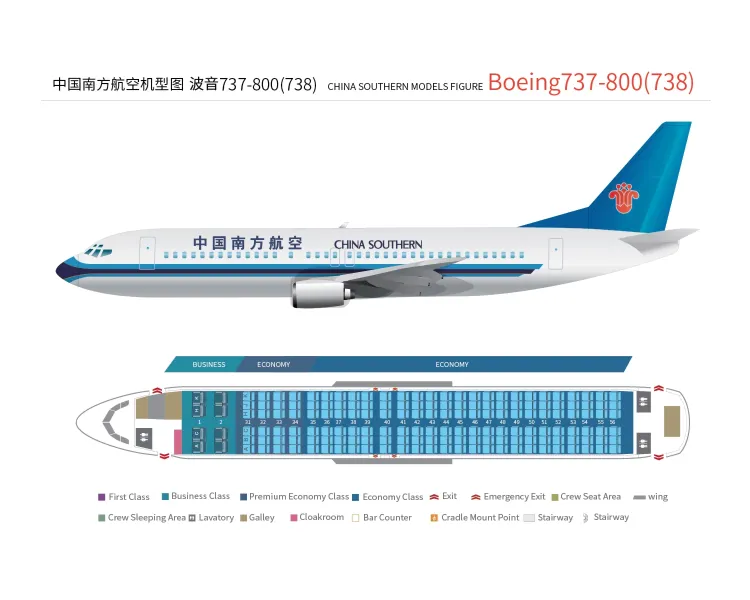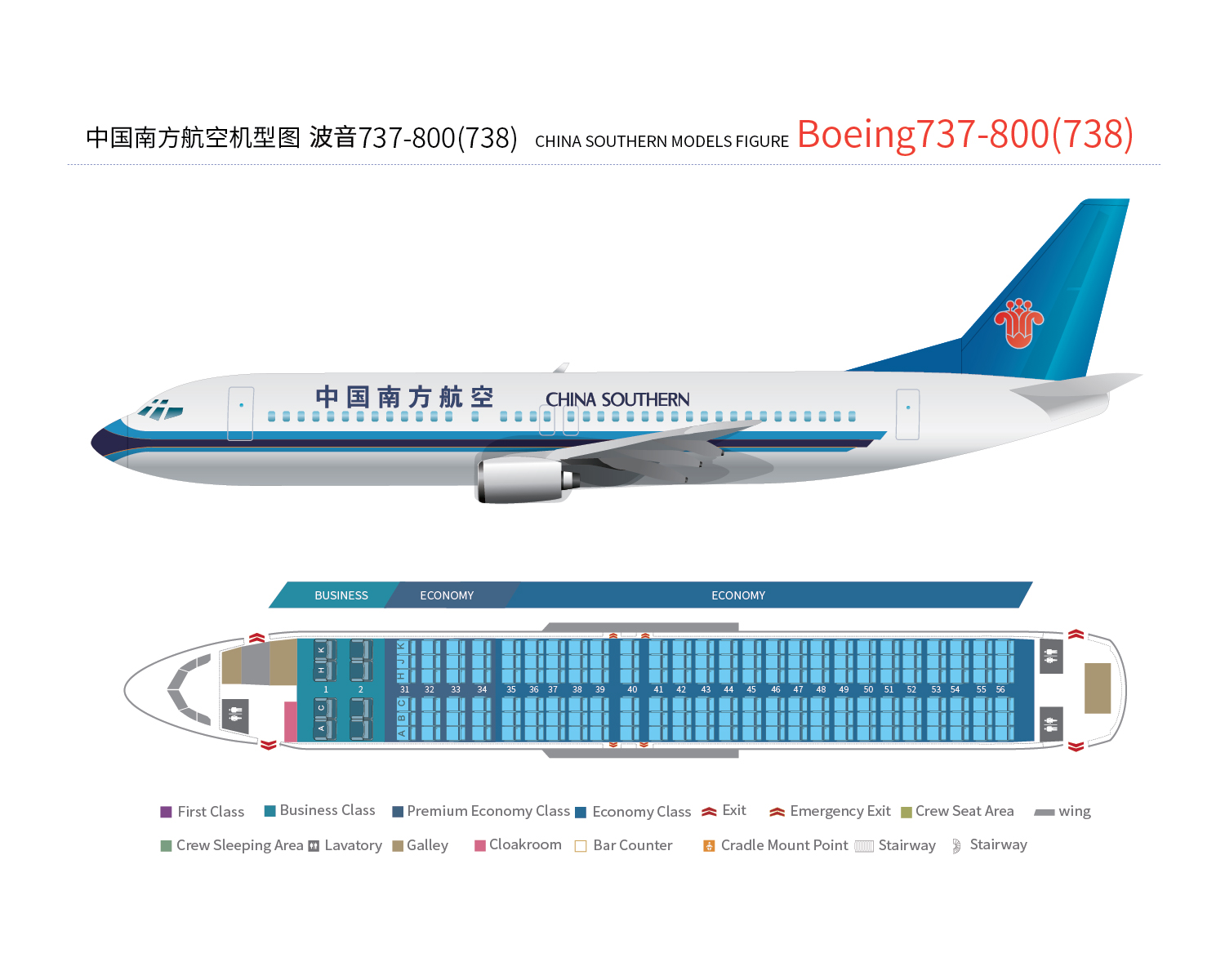
Boeing 737 Aircraft Overview and Seat Selection Guide

The Boeing 737 is the world’s best-selling single-aisle aircraft and a mainstay on short- to medium-haul routes across Asia, North America, and Europe. In this article, we focus on the Boeing 737-800—a common variant operated by many regional airlines—and provide a complete guide to its cabin configuration, seat types, and practical recommendations based on actual layouts from China Southern Airlines.
1. Boeing 737 Overview
- Type: Single-aisle narrow-body aircraft
- Variants: Includes 737-700, 737-800, 737-900, and 737 MAX 8
- Range: Approximately 4,500–5,700 km
- Typical Capacity: Around 150–190 passengers (varies by airline)
- Common Routes: Short- to mid-haul flights such as Taipei–Bangkok, Kaohsiung–Singapore, Taichung–Hong Kong, and Taipei–Tokyo
Airlines Commonly Operating the 737
- From Taiwan: China Airlines (regional), Mandarin Airlines, Tigerair Taiwan
- International carriers: VietJet, Scoot, AirAsia, and Chinese airlines like China Southern, China Eastern, and Hainan Airlines
2. Cabin Layout (Example: China Southern Airline Boeing 737-800)

Image Source: China Southern Airline
Cabin Sections
- Business Class: Row 1
- Economy Class: Rows 31–59
- Rows 31–33 are designated as "Pearl Economy Class" (premium economy branding), but the seat design is the same as standard economy—no headrests, no cup holders
- Rows 31–33 are designated as "Pearl Economy Class" (premium economy branding), but the seat design is the same as standard economy—no headrests, no cup holders
- Emergency Exit Rows: Rows 42–43
- Overwing Area: Rows 37–45
- Lavatories: 3 total
- 1 at the front of business class
- 2 at the rear (Row 59), including a wheelchair-accessible lavatory and a baby changing table
- 1 at the front of business class
Cabin Configuration
- Standard 3-3 seating layout (ABC / DEF)
- A and F are window seats; C and D are aisle seats; B and E are middle seats
- Seat pitch: approx. 30–31 inches; Seat width: approx. 17–18 inches
- Pearl Economy Class passengers get early boarding but no seat upgrades
3. Seat Selection Guide – China Southern Boeing 737 Edition
Recommended Seats
- Row 31 (First Row of Economy)
- Extra legroom; ideal for tall passengers
- Tray table stored in the armrest; no window
- Sold as Pearl Economy Class (higher fare or mileage upgrade eligible)
- Quiet and convenient for quick disembarkation
- Extra legroom; ideal for tall passengers
- Rows 42–43 (Emergency Exit Rows)
- Generous legroom with no seats in front
- Must store personal items overhead; some seatbacks may not recline
- Wing may obstruct views, limiting photo opportunities
- Generous legroom with no seats in front
- Rows 36–37
- Ideal for engine and wing views
- However, aligned with the engines—this is the loudest area in the cabin
- Ideal for engine and wing views
- Rows 50–52 and beyond
- Located behind the wing, offering unobstructed views
- Great for passengers seeking peace and window photography
- Located behind the wing, offering unobstructed views
- Row 62 A/K (Window seats)
- No obstruction in front, extra space
- Center seats (DEG) in this row also have more legroom
- No obstruction in front, extra space
Seats to Avoid
- Row 41: Just in front of the emergency exit row; seatbacks do not recline—can be uncomfortable on long flights
- Row 59 (last row): Near lavatories, limited recline, more foot traffic and odor
- Middle seats (B/E): Less personal space, shared armrests, only recommended if no other options
- Row 36: Directly in line with the engine, making it the noisiest row on the aircraft
4. Seat Selection Based on Views
- Engine + Wing Views: Rows 36–37
- Wing Views Only: Rows 46–48
- Tail Fin + Airline Logo (for photos): Rows 50–51
- Clear, unobstructed views: Rows 31–33 and from Row 52 onward
5. View and Direction Tips (for Sunrise/Sunset Flights)
- For travelers who enjoy sunrises, sunsets, or city skylines, select a window seat according to the direction of travel:
- Northbound flights: Morning – choose left side (A); Evening – choose right side (F)
- Southbound flights: Reverse the above
- Northbound flights: Morning – choose left side (A); Evening – choose right side (F)
- Avoid rows over the wings (Rows 37–45) if you want an unobstructed window view
6. Current Boeing 737-800 (B738) Direct Flight Routes
Flight Number | Aircraft Type | Departure Airport | Arrival Airport |
|---|---|---|---|
7C1328 | Boeing 737-800 | Kansai International Airport (KIX / RJBB) | Gimpo International Airport (GMP / RKSS) |
UQ2558 | Boeing 737-800 | Xiamen Gaoqi International Airport (XMN / ZSAM) | Wuhan Tianhe International Airport (WUH / ZHHH) |
HU7468 | Boeing 737-800 | Zhuhai Jinwan Airport (ZUH / ZGSD) | Hangzhou Xiaoshan International Airport (HGH / ZSHC) |
MF866 | Boeing 737-800 | Singapore Changi Airport (SIN / WSSS) | Fuzhou Changle International Airport (FOC / ZSFZ) |
CA115 | Boeing 737-800 | Beijing Capital International Airport (PEK / ZBAA) | Hong Kong International Airport (HKG / VHHH) |
7. Summary
While the Boeing 737 is a standard narrow-body aircraft for short to medium routes, smart seat selection can make a noticeable difference in comfort. Based on China Southern’s layout, factors like legroom, seat recline, window alignment, engine noise, and lavatory proximity all contribute to a better or worse experience.
Passengers are advised to plan ahead and select seats based on their priorities—whether it’s quick boarding, a quieter cabin, better window views, or more legroom. Even across other airlines operating the Boeing 737, the same seating logic generally applies.
Seat Selection Guide for Popular Airbus and Boeing Aircraft
- Airbus A380 Seat Map & Aircraft Overview
- Airbus A320 Seat Map & Aircraft Overview
- Airbus A350-900 Seat Map & Aircraft Overview
- Boeing 737 Seat Map & Aircraft Overview
- Boeing 747-400 Seat Map & Aircraft Overview
- Boeing 787-9 Seat Map & Aircraft Overview
- Airbus A320 NEO Seat Map & Aircraft Overview
- Airbus A321 NEO Seat Map & Aircraft Overview
- Airbus A380-800 Seat Map & Aircraft Overview
- Airbus A359 Seat Map & Aircraft Overview
- Airbus A321 Seat Map & Aircraft Overview
- Airbus A330-300 Seat Map & Aircraft Overview
- Boeing 787-10 Seat Map & Aircraft Overview
- Boeing 737 MAX Seat Map & Aircraft Overview
- Boeing 737-800 Seat Map & Aircraft Overview
- ATR72 787-10 Seat Map & Aircraft Overview
